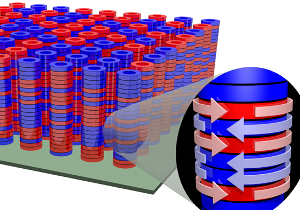 Context. Spintronics has become a mature technology for applications, such as magnetic field sensing and solid-state memories. However, existing concepts are almost exclusively based on planar processes such as thin film deposition and patterning. Extending spintronics to 3D devices would provide new integrated functionalities such as three-dimensional magnetic field sensors, and also open prospects for an increase of data retention or capacity for future generations of solid-state memories. On the fundamental side, exploring the third dimension brings new physics related to curvature-induced effects and new topologies for magnetization textures. This is the fast-growing field of curvilinear magnetism.
Context. Spintronics has become a mature technology for applications, such as magnetic field sensing and solid-state memories. However, existing concepts are almost exclusively based on planar processes such as thin film deposition and patterning. Extending spintronics to 3D devices would provide new integrated functionalities such as three-dimensional magnetic field sensors, and also open prospects for an increase of data retention or capacity for future generations of solid-state memories. On the fundamental side, exploring the third dimension brings new physics related to curvature-induced effects and new topologies for magnetization textures. This is the fast-growing field of curvilinear magnetism.
Context at SPINTEC. The position is open in the framework of C3DS, a binational French-German ANR-DFG project (https://www.spintec.fr/c3ds-an-anr-dfg-project/). The purpose of C3DS is to develop and
demonstrate the functionality of basic spintronic building blocks suitable for 3D integration. We will use the tubular geometry, compatible with deeply-3D integration in vertical pores, and which allows core-shell structures to be obtained as required to achieve spintronic effects. At SPINTEC the project involves both the Spin Textures team and the Theory/Simulation team, in close collaboration with Institut Néel, also a partner of the C3DS project.
Single-wall and core-shell magnetic nanotubes have been developed by the German partners, and are now available for investigations. Here, the project consists in using the electric current flowing through the nanotube, in particular through its core, to induce the motion of domain walls, and the emission of spin waves. We will seek to evidence effects related to curvature, showing up as chiral and non-reciprocal effects. The post-doctoral fellow will be responsible of nanofabrication for electrical contacting, dc and ac electrical measurements including combined with magnetic force microscopy in the lab, and will be largely involved in TEM imaging with magnetic modes, and XMCD and STXM magnetic imaging at synchrotron facilities. She/he will also be interacting closely with the German partners in charge of chemical synthesis, and those Grenoble colleagues developing micromagnetic models and conducting micromagnetic simulations. She/He may be involved in the supervision of Master students and PhD candidates. Participation to international research schools and conferences is encouraged and will be supported. The salary is provided through CNRS. The gross salary depends on the carrier stage of the fellow. The candidate will benefit from CNRS workers conditions, such as subsidized local transportation and privileged access to sporting activities.
Requirements. Applicants must have a PhD diploma with expertise in one or several of these fields: nanomagnetism/spintronics, clean-room facilities, electrical measurements. They should display taste for experimental physics and collaborative work, with good understanding of condensed matter physics. Offer details.Download flyer. Link to apply: https://t.co/mO6o3OCD8z.
Contact. Olivier Fruchart




